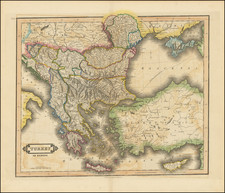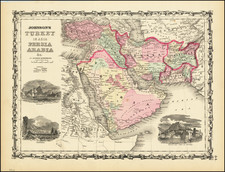The First Map of Asia Minor Published North of the Alps
Striking example of Greco-Roman geographer and astronomer Claudius Ptolemy's mapping of Asia Minor, drawn from his monumental Geographia, his 2nd Century A.D. treatise which would become the single most important early Renaissance view of the classical world and influence Renaissance cartography for over two centuries.
The first Asian region (Prima Tabula) covered by Ptolemy Asia Minor, a region corresponding to modern-day Turkey. Ptolemy's depiction of this area, captured in the map Prima Asiae Tabula, underwent a fascinating evolution, of one of the high points was its appearance in the 1482 Ulm edition of Ptolemy's Geographia.
Ptolemy's original work on Asia Minor was based on earlier sources, most of which are lost today. His maps, including Prima Asiae Tabula, were likely not visually represented in his original manuscript but were instead provided as detailed instructions allowing cartographers to recreate the geographical layout. Ptolemy's Asia Minor was divided into precise coordinate points using a grid system, based on longitudinal and latitudinal lines.
Nicolaus Germanus, a Benedictine monk of the 15th century, played a significant role in reviving Ptolemy's work. His manuscript editions of Geographia included one of the earliest known examples of maps created following Ptolemy's instructions, bringing a visual component to Ptolemy's geographic descriptions. In his depiction of Asia Minor, Germanus applied Ptolemy's coordinates to construct a relatively accurate layout of the region, emphasizing the peninsular shape of Asia Minor and the prominence of the Aegean and Black Seas.
The 1482 Ulm edition of Ptolemy's Geographia is considered to be one of the visual high points of the Ptolemaic mapping tradition. This edition, printed by Lienhart Holle, was the first edition of Geographia to be printed north of the Alps, and the first to incorporate woodcut maps, a technique that allowed for more detailed and mass-produced images. The Ulm edition's depiction of Asia Minor was notably more detailed and aesthetically refined, while still fundamentally adhering to Ptolemy's original geographic model. Moreover, this was the first edition to regularly include hand coloring, with the publisher's lavish use of ultramarine Lapis Lazuli for the seas and oceans of the world, a blue pigment more expensive than gold, ultimately bankrupting the publication project. The 1486 edition, issued by Johann Reger, would quickly abandon ultramarine, in favor of a more financially viable taupe brown wash for coloring the the seas.
The 1482 Ulm Ptolemy map of Asia Minor reveals a region that is instantly recognizable, with the Black Sea to the north, the Mediterranean to the south, and the Aegean Sea to the west. Significant cities, such as Byzantium (Istanbul), are also marked, reflecting their importance during Ptolemy's time.
Rarity
The 1482 Ptolemy maps are rare on the market.
This is the first time we have offered Asie Prima Tabula.
The Ulm Ptolemy of 1482 and 1486
The Ulm edition of Ptolemy was first published in 1482 by Lienhart Holle. In contrast to the two earlier illustrated editions of Ptolemy's geography - Bologna (1477) and Rome (1478) - the maps in the Ulm edition are woodblock prints, not copperplate engravings. The maps in the Ulm edition follow the manuscript maps of Donnus Nicolaus Germanus, a Benedictine monk from Breslau who produced brilliant presentation copies for Italian elites in the 1460s and 1470s. Specifically, the Ulm was patterned after the manuscript atlas prepared for Pope Paul II. The Ulm Ptolemy was the first book Holle published, but it was also to be one of his last. Holle went bankrupt shortly after the original publication. The work was then taken over by Johann Reger, who issued another edition in 1486.
The differences between the two editions are relatively small. The 1486 maps typically include titles at the top, whereas there were no titles on the 1482 maps. An unpublished study of the individual maps reveals that there are multiple states of most of the maps.
It had long been suggested that the way to differentiate between the 1482 and 1486 editions was the use of lapis lazuli blue in the 1482 edition for the seas, whereas the 1486 used brown. However, the same unpublished study, which evaluated dozens of examples of the two editions, determined that the earliest examples of the 1486 were also issued with the lapis lazuli blue, suggesting that when Johann Reger acquired the woodblocks, he likely also acquired some unused lapis lazuli. In 2021, we offered for sale a complete example of a 1486 entirely in lapis lazuli blue.
Claudius Ptolemy (fl. AD 127-145) was an ancient geographer, astronomer, and mathematician. He is known today through translations and transcriptions of his work, but little is known about his life besides his residence in Alexandria.
Several of his works are still known today, although they have passed through several alterations and languages over the centuries. The Almagest, in thirteen books, discusses astronomy. It is in the Almagest that Ptolemy postulates his geocentric universe. His geometric ideas are contained in the Analemma, and his optical ideas were presented in five books known as the Optica.
His geographic and cartographic work was immensely influential. In the Planisphaerium, Ptolemy discusses the stereographic projection. Perhaps his best-known work is his Geographia, in eight books. However, Ptolemy’s ideas had been absent from western European intellectual history for roughly a thousand years, although Arab scholars interacted with his ideas from the ninth century onward.
In 1295, a Greek monk found a copy of Geographia in Constantinople; the emperor ordered a copy made and the Greek text began to circulate in eastern Europe. In 1393, a Byzantine diplomat brought a copy of the Geographia to Italy, where it was translated into Latin in 1406 and called the Cosmographia. The manuscript maps were first recorded in 1415. These manuscripts, of which there are over eighty extant today, are the descendants of Ptolemy’s work and a now-lost atlas consisting of a world map and 26 regional maps.
When Ptolemy’s work was re-introduced to Western scholarship, it proved radically influential for the understanding and appearance of maps. Ptolemy employs the concept of a graticule, uses latitude and longitude, and orients his maps to the north—concepts we take for granted today. The Geographia’s text is concerned with three main issues with regard to geography: the size and shape of the earth; map projection, i.e. how to represent the world’s curve proportionally on a plane surface; and the corruption of spatial data as it transfers from source to source. The text also contains instructions as to how to map the world on a globe or a plane surface, complete with the only set of geographic coordinates (8000 toponyms, 6400 with coordinates) to survive from the classical world.











![L. Rouwolfs Reys-Togten, door de Levant, of Oosterse Landschappen der Middellandse Zee [shows Cyprus]](https://storage.googleapis.com/raremaps/img/small/83622.jpg)
![[ Greece, Bulgaria, Albania, Macedonia, Serbia & Turkey ] Tabula Europae IX](https://storage.googleapis.com/raremaps/img/small/74916.jpg)

